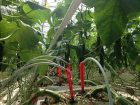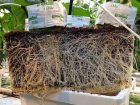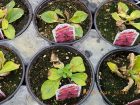
Features
Growing Media
Inputs
Root Health is Hidden Wealth
Two vegetable growers in Western Canada offer their insights into what to look for beneath the surface of your growing media, and how it reflects on plant health.
March 1, 2016 By Dr. Mohyuddin Mirza
March 2016 — Roots are the foundation of plants we grow in greenhouses. In the February 2013 issue of Greenhouse Canada, I wrote about root health and it’s importance in crop management.
This time I asked two vegetable growers to share with the readers what comes to mind when we talk about rootzone and root health.
Trevor Schriemer of Precision Produce in Otterburne, Man., provided his input. The following are his comments, in quotations.
“Good afternoon Dr. Mirza; here are some of my thoughts regarding rootzone health. It is not exhaustive and you would of course have much to add, but this is what immediately springs to mind.
“Slits in the grow bag should be made near the bottom so that excess water will not build up and damage roots. Slits should allow almost complete drainage. A large reservoir maintained in the bag reduces the volume of aerated rootzone, which plants need to grow optimally.
“DO (dissolved oxygen) content is important for root health and every grower should know his DO content. If it is too low (below four ppm), then diffused oxygen technology should be employed. High 02 levels in the rootzone reduce the need for expensive applications of pythium-controlling fungicides. Low 02 levels affect ion uptake. This happens at the root hair level, which is stimulated by high 02 levels.
“The need for washed coco is important, because unwashed coco tends to have consistently higher pH levels that are hard to bring down. Also, washed coco with a prescribed EC is important for the quick penetration of roots from young transplants.
“Pay attention to EC and pH levels in the rootzone every day and specifically when light and VPD levels are highest, especially with the EC.
“Timing of first drain is important, much more important than the per cent of drain over the 24-hour period.
“Media temperature is important to avoid iron deficiencies and reduced growth.”
Schriemer has brought up very important points regarding root health from a practical viewpoint. I am a big fan and promoter of dissolved oxygen in the nutrient solution. Oxygen solubility is strongly dependent on water temperature and decreases with higher temperatures. The higher the dissolved solids, the lower the oxygen levels.
At 4 C water temperature, the dissolved oxygen is around eight to nine mg/L (parts per million, ppm). Water is heated for greenhouse irrigation use and at 20 C, the oxygen level drops to around five to six ppm.
I did several actual measurements and found that when the water goes through irrigation pipes, the level at drip line dropped to around four to five ppm. When I measured oxygen levels in leach solution, they ranged from two to three ppm. In one case it was around one ppm. That is almost anaerobic levels. These measurements were done with cucumbers grown in coir growing medium.
Many oxygen meters give a reading on “saturation percentage” rather than mg/L. Eight to nine mg/L is considered close to 100 per cent saturation.
Roots don’t carry out photosynthesis like leaves do and they don’t have stomata either. Roots are very dynamic in the sense that they are constantly developing and growing.
The top photo on page 38 shows a rootzone from a crop of mini cucumbers. The crop was seeded in the middle of September, with harvesting beginning in late October. This photo was taken the third week of January. There are good “feeder” roots visible with root hair. Cucumber plants need to constantly produce new roots and when the roots are bathed with nutrient solution with dissolved oxygen of around eight ppm, then the health is in the “good” range.
How best to oxygenate the nutrient solution? Schriemer is using a “diffused oxygen” system where he is able to maintain around eight to nine ppm of dissolved oxygen at a temperature of about 18 C. This particular technology is from Seair. I know there are many other companies in this area of oxygen generation and diffusion, so check them all out. I believe that growers should invest in a reliable oxygen diffusion or enrichment system.
Schriemer noted that the danger of pythium can be reduced if oxygen levels in the rootzone are maintained above four ppm. This root rot fungus likes lower oxygen conditions in the rootzone.
The other inputs that affect rootzone health are also mentioned by Schriemer as well. Note that pH is probably at the top of the list, after oxygen. The pH levels constantly change and fluctuate as the crop is growing. Normally what happens is that as plants are growing and fruiting, the pH will start climbing and moving towards the alkaline side. If you don’t watch it daily, the pH will suddenly climb to over 6.8 and you will notice when there is iron deficiency in the new growth.
Many growers will drop the feed pH to around 5.1 to 5.4. I believe this is very low pH for the roots and I have seen root tip damage develop quickly. A better approach is to monitor the pH daily, watch for a trend going up or down, and make adjustments before you have to intervene drastically.
ERIC DOEF OF DOEF’S GREENHOUSES
I also asked Eric Doef, at Doef’s Greenhouses in Lacombe, Alta., for his comments. He was one of Greenhouse Canada’s Top 10 Under 40 winners last year.
For starters, he sent me two pictures (Photo 2, page 38, and Photo 3) to illustrate key points.
These are pictures of a mature crop of long English cucumbers. They are grown in plastic buckets with 11L of coir and there are four plants in each bucket. Thus there are 2.75L of coir per plant. This means that roots will be developing in areas where extra water drains out and on the outside of the growing medium. One can see roots on the side and at the base of the bucket.
Doef mentioned the following points in the context of root health. The statements in bold are Doef’s comments and the rest are what I have added.
- Water quality affects rootzone health. Not only the chemical quality, such as high levels of sodium, will affect the roots. Sodium also destroys the drainage characteristics of the growing medium and thus creates waterlogged conditions.
- Dissolved oxygen levels have a very big role to play in maintaining proper root health. High organic matter and microbial load can create an “oxygen consumption” situation. That is why growers must know the biochemical oxygen demand (BOD) of their water supply. BOD is the amount of dissolved oxygen needed (i.e. demanded) by aerobic biological organisms to break down organic material present in a given water sample at a certain temperature over a specific time period.
- Electrical conductivity (EC) – high or low or proper levels – can have a significant effect on root health. High EC under high light conditions can restrict the uptake of water and thus affect the leaf size.
- Choice of media is also very important for maintaining good root health. It is related to air porosity and water-holding capacity of the growing mixes. Coir is available in different forms – coarse, medium and fine. Growers should choose the growing medium based on the crops they are growing.
- Sodium levels build up in the growing media over a period of time. Cucumbers are sensitive to higher levels of sodium in the rootzone.
- Proper irrigation strategies adjusted to light and temperature are very important to maintaining good rootzone health. Growers should pay more attention to vapour pressure deficit (VPD) to start first irrigation, not just at sunrise.
- Once in a while check the root health by checking for the presence of white absorbing root hair, good root tips and also how roots are distributed in the growing medium. There should be good distribution all across the growing medium.
BEDDING PLANT SEASON
With the bedding plant season upon us, I want to share two pictures (Photo 4 and Photo 5) that indicate issues with root health.
Photo 4 is an example where attention was not paid to pH in the rootzone. These petunias are showing iron deficiency caused by alkaline pH in the rootzone. It will take at least three weeks to turn this crop around and these plants can be un-saleable. Photo 5 is where waterlogged conditions prevailed and roots did not develop properly. Adjust your watering practices to avoid waterlogged situations.
The top growth of the plants can tell us about the health of the roots. Learn to read the plants and make decisions accordingly.
Dr. Mohyuddin Mirza is an industry consultant. He can be contacted at drmirzaconsultants@gmail.com.
Print this page




